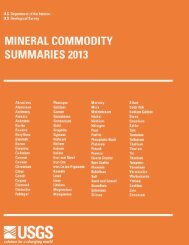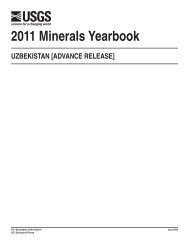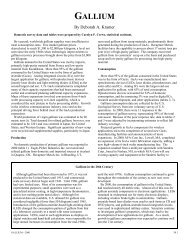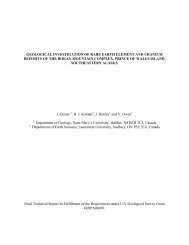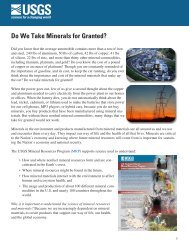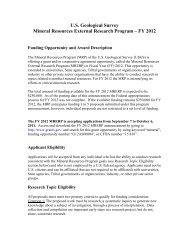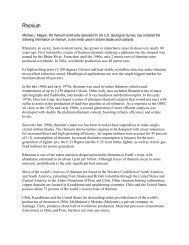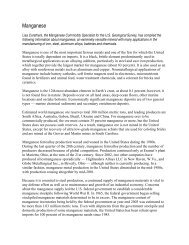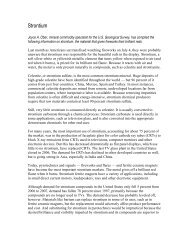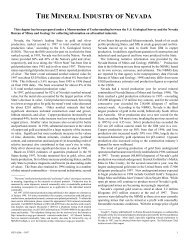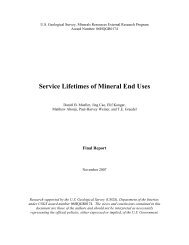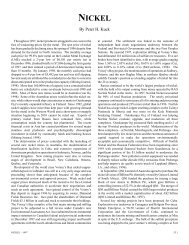Mineral Commodity Summaries 2003 - Mineral Resources Program ...
Mineral Commodity Summaries 2003 - Mineral Resources Program ...
Mineral Commodity Summaries 2003 - Mineral Resources Program ...
Create successful ePaper yourself
Turn your PDF publications into a flip-book with our unique Google optimized e-Paper software.
MERCURY<br />
Events, Trends, and Issues: Federal, State, and local governments are concerned about the toxic effects of mercury<br />
and therefore regulate mercury emissions and/or the final disposition of mercury-bearing products. As a result,<br />
stringent environmental standards are likely to continue as the major determinants of domestic mercury supply and<br />
demand. The major component of supply will remain the secondary industry, owing to the recycling of many worn out<br />
or obsolete products and various wastes to avoid deposition in landfills. Domestic primary production is expected to<br />
remain limited to byproduct production where the mercury is recovered to avoid emissions to the environment.<br />
Domestic mercury consumption will continue to decline as mercury is gradually eliminated in many products or as<br />
substitute products are developed.<br />
Sales from the National Defense Stockpile remained suspended.<br />
World Mine Production, Reserves, and Reserve Base:<br />
Mine production Reserves 4<br />
Reserve base 4<br />
2001 2002 e<br />
United States NA NA — 7,000<br />
Algeria 240 220 2,000 3,000<br />
Italy — — — 69,000<br />
Kyrgyzstan 300 300 7,500 13,000<br />
Spain 500 500 76,000 90,000<br />
Other countries 360 400 38,000 61,000<br />
World total (may be rounded) 1,400 1,400 120,000 240,000<br />
World <strong>Resources</strong>: World mercury resources are estimated at nearly 600,000 tons, principally in Kyrgyzstan, Russia,<br />
Slovenia, Spain, and Ukraine. These are sufficient for another century or more, especially with declining consumption<br />
rates.<br />
Substitutes: Lithium, nickel-cadmium, and zinc-air batteries are substitutes for mercury-zinc batteries. Indium<br />
compounds substitute for mercury in alkaline batteries. Diaphragm and membrane cells replace mercury cells in the<br />
electrolytic production of chlorine and caustic soda. Ceramic composites can replace dental amalgams; organic<br />
compounds have replaced mercury fungicides in latex paint. Digital instruments have replaced mercury thermometers<br />
in many applications.<br />
e Estimated. NA Not available. — Zero.<br />
1 Prepared by Robert G. Reese, Jr.<br />
2 One metric ton (1,000 kilograms) = 29.0082 flasks.<br />
3 See Appendix B for definitions.<br />
4 See Appendix C for definitions.<br />
109<br />
U.S. Geological Survey, <strong>Mineral</strong> <strong>Commodity</strong> <strong>Summaries</strong>, January <strong>2003</strong>



